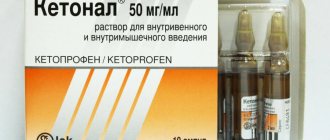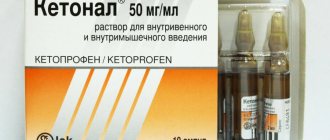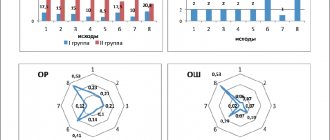Targin®
Oxycodone hydrochloride
Suction.
After oral administration, oxycodone exhibits high absolute bioavailability, reaching 87%.
Distribution.
Once absorbed, oxycodone is distributed throughout the body. About 45% binds to plasma proteins. Oxycodone crosses the placenta and is found in breast milk.
Metabolism.
Oxycodone is metabolized in the intestine and liver to form noroxycodone, oxymorphone and various metabolites in the form of glucuronides. Isoenzymes of the cytochrome P450 system are involved in the formation of noroxycodone, oxymorphone and noroxymorphone.
Quinidine reduces the formation of oxymorphone in humans without significantly affecting the pharmacodynamic effects of oxycodone. The contribution of metabolites to the overall pharmacodynamic effect is insignificant.
Excretion.
Oxycodone and its metabolites are excreted by the kidneys and intestines.
Naloxone hydrochloride
Suction.
When taken orally, naloxone has very low systemic bioavailability - less than 3%.
Distribution.
Naloxone penetrates the placental barrier. It is not known whether naloxone passes into breast milk.
Metabolism and excretion.
Metabolized in the liver and excreted by the kidneys. The main metabolites are naloxone glucuronide, 6β-naloxol and its glucuronide.
Combination of oxycodone hydrochloride + naloxone hydrochloride (Targin®)
The pharmacokinetic properties of oxycodone, which is part of Targin®, correspond to the properties of oxycodone in the extended-release tablet dosage form, taken together with extended-release naloxone tablets.
All dosages of Targin® are interchangeable.
After oral administration of the drug Targin® at the maximum dose by healthy volunteers, the concentration of naloxone in plasma is so low that it is not possible to conduct a pharmacokinetic analysis of it. Therefore, naloxone-3-glucuronide was used as a surrogate marker, since its concentration in plasma is sufficient for measurements.
In general, when administered with a high-fat meal compared to fasting, the plasma bioavailability and Cmax of oxycodone increased by an average of 16 and 30%, respectively. However, Targin® tablets can be taken with or without food.
In vitro results
Metabolism studies have shown that the development of clinically significant interactions with the components of the drug is unlikely.
Elderly patients
Oxycodone.
In elderly patients, compared with young volunteers, an increase in the AUCτ value of oxycodone was observed, on average up to 118%. Cmax of oxycodone increased to an average of 114%. Oxycodone Cmin increased to an average of 128%.
Naloxone.
In elderly patients, compared with young volunteers, an increase in the AUCτ value of naloxone was observed on average up to 182%. Cmax of naloxone increased to an average of 173%. Naloxone Cmin increased to an average of 317%.
Naloxone-3-glucuronide.
In elderly patients, compared with young volunteers, an increase in the AUCτ value of naloxone-3-glucuronide was observed on average up to 128%. Cmax of naloxone-3-glucuronide increased to an average of 127%. Oxycodone Cmin increased to an average of 125%.
Patients with liver dysfunction
Oxycodone.
In patients with mild, moderate, and severe hepatic impairment, compared with healthy volunteers, oxycodone AUC∞ increased to an average of 143%, 319%, and 310%, respectively. Oxycodone Cmax increased to an average of 120, 201, and 191%, and T1/2Z values increased to an average of 108, 176, and 183%, respectively.
Naloxone.
In patients with mild, moderate, and severe hepatic impairment, compared with healthy volunteers, an increase in naloxone AUCt was observed to average 411%, 11518%, and 10666%, respectively. Cmax of naloxone increased to an average of 193, 5292 and 5252%, respectively. Due to insufficient data, T1/2Z values and corresponding AUC∞ values for naloxone were not calculated. Therefore, comparisons of naloxone bioavailability were based on AUCt values.
Naloxone-3-glucuronide.
In patients with mild, moderate and severe hepatic impairment, compared with healthy volunteers, an increase in the AUC∞ value of naloxone-3-glucuronide was observed to average 157, 128 and 125%, respectively. The Cmax of naloxone-3-glucuronide increased to an average of 141.118% and decreased to 98%, and the T1/2Z values of naloxone-3-glucuronide increased to an average of 117% and decreased to 77 and 94%, respectively.
Patients with impaired renal function
Oxycodone.
In patients with mild, moderate, and severe renal impairment, compared with healthy volunteers, oxycodone AUC∞ increased to an average of 153%, 166%, and 224%, respectively. Oxycodone Cmax increased to an average of 110, 135, and 167%, and oxycodone T1/2Z values increased to an average of 149, 123, and 142%, respectively.
Naloxone.
In patients with mild, moderate, and severe renal impairment, compared with healthy volunteers, naloxone AUCt values increased to an average of 2850%, 3910%, and 7612%, respectively. Cmax of naloxone increased to an average of 1076, 858 and 1675%, respectively. Due to insufficient data, T1/2Z values and corresponding AUC∞ values for naloxone were not calculated. Therefore, comparisons of naloxone bioavailability were based on AUCt values. The calculated ratios may have been affected by the inability to fully characterize plasma naloxone profiles in healthy volunteers.
Naloxone-3-glucuronide.
In patients with mild, moderate and severe renal impairment, compared with healthy volunteers, an increase in the AUC∞ value of naloxone-3-glucuronide was observed on average to 220, 370 and 525%, respectively.
Cmax of naloxone-3-glucuronide increased to an average of 148, 202 and 239%, respectively. On average, there were no significant differences in the T1/2Z value of naloxone-3-glucuronide in patients with renal failure compared with healthy volunteers.
Incorrect use
To maintain the properties of the extended-release drug, the tablets should be swallowed whole without breaking, chewing or crushing. When the extended-release tablet is broken, chewed, or crushed, the active ingredients are released more rapidly, which may result in the absorption of a potentially lethal dose of oxycodone (see Overdose) and may result in a marked increase in systemic naloxone exposure. In addition, after intranasal administration, the effective (antagonistic) concentration of naloxone in the blood plasma will persist for several hours. Both properties appear to be protective against the abuse of naloxone/oxycodone extended-release tablets. Intentional parenteral administration of drugs intended for oral administration can lead to the development of serious adverse drug reactions, incl. with fatal outcome. In oxycodone-dependent rats, intravenous administration of a combination of oxycodone hydrochloride + naloxone hydrochloride in a 2:1 ratio led to the development of withdrawal syndrome.
Targin 10mg+20mg tab p/o prolong No. 20
Oxycodone hydrochloride
Suction
After oral administration, oxycodone exhibits high absolute bioavailability, reaching 87%.
Distribution
Once absorbed, oxycodone is distributed throughout the body. About 45% binds to plasma proteins. Oxycodone crosses the placenta and is found in breast milk.
Metabolism
Oxycodone is metabolized in the intestine and liver to form noroxycodone, oxymorphone and various metabolites in the form of glucuronides. Isoenzymes of the cytochrome P450 system are involved in the formation of noroxycodone, oxymorphone and noroxymorphone. Quinidine reduces the formation of oxymorphone in humans without significantly affecting the pharmacodynamic effects of oxycodone. The contribution of metabolites to the overall pharmacodynamic effect is insignificant.
Removal
Oxycodone and its metabolites are excreted by the kidneys and intestines.
Naloxone hydrochloride
Suction
When taken orally, naloxone has very low systemic bioavailability - less than 3%.
Distribution
Naloxone penetrates the placental barrier. It is not known whether naloxone passes into breast milk.
Metabolism and excretion
Metabolized in the liver and excreted by the kidneys. The main metabolites are naloxone glucuronide, 6β-naloxol and its glucuronide.
Oxycodone hydrochloride/naloxone hydrochloride combination (Targin®)
The pharmacokinetic properties of oxycodone, which is part of Targin®, correspond to the properties of oxycodone in the extended-release tablet dosage form, taken together with extended-release naloxone tablets.
All dosages of Targin® are interchangeable.
After oral administration of the drug Targin® at the maximum dose by healthy volunteers, the concentration of naloxone in plasma is so low that it is not possible to conduct a pharmacokinetic analysis of it. Therefore, naloxone-3-glucuronide was used as a surrogate marker, since its concentration in plasma is sufficient for measurements.
In general, when administered with a high-fat meal compared to fasting, the bioavailability and maximum plasma concentration (Cmax) of oxycodone increased by an average of 16 and 30%, respectively. However, Targin® tablets can be taken with or without food.
In vitro results
Metabolism studies have shown that the development of clinically significant interactions with the components of the drug is unlikely.
Pharmacokinetics in selected patient groups
Elderly patients
Oxycodone
In elderly patients, compared with young volunteers, an increase in the area under the concentration-time curve (AUCτ) of oxycodone was observed, on average up to 118%. Cmax of oxycodone increased to an average of 114%. The minimum concentration (Cmin) of oxycodone increased to an average of 128%.
Naloxone
In elderly patients, compared with young volunteers, an increase in the AUCτ value of naloxone was observed on average up to 182%. Cmax of naloxone increased to an average of 173%. Naloxone Cmin increased to an average of 317%.
Naloxone-3-glucuronide
In elderly patients, compared with young volunteers, an increase in the AUCτ value of naloxone-3-glucuronide was observed on average up to 128%. Cmax of naloxone-3-glucuronide increased to an average of 127%. Oxycodone Cmin increased to an average of 125%.
Patients with liver dysfunction
Oxycodone
In patients with mild, moderate, and severe hepatic impairment, compared with healthy volunteers, the AUC∞ of oxycodone increased to an average of 143, 319, and 310%, respectively. Oxycodone Cmax increased to an average of 120, 201, and 191%, and t1/2Z values increased to an average of 108, 176, and 183%, respectively.
Naloxone
In patients with mild, moderate and severe hepatic impairment, compared with healthy volunteers, an increase in the AUCτ value of naloxone was observed on average to 411, 11518 and 10666%, respectively. Cmax of naloxone increased to an average of 193, 5292 and 5252%, respectively. Due to insufficient data, t1/2Z values and corresponding AUC∞ values for naloxone were not calculated. Therefore, comparisons of naloxone bioavailability were based on AUCτ values.
Naloxone-3-glucuronide
In patients with mild, moderate and severe hepatic impairment, compared with healthy volunteers, an increase in the AUC value of naloxone-3-glucuronide was observed on average to 157, 128 and 125%, respectively. Cmax of naloxone-3-glucuronide increased to an average of 141.118% and decreased to 98%, and the t1/2Z values of naloxone-3 increased to an average of 117% and decreased to 77 and 94%, respectively.
Patients with impaired renal function
Oxycodone
In patients with mild, moderate, and severe renal impairment, compared with healthy volunteers, oxycodone AUC∞ increased to an average of 153%, 166%, and 224%, respectively. Oxycodone Cmax increased to an average of 110, 135, and 167%, and oxycodone t1/2Z values increased to an average of 149, 123, and 142%, respectively.
Naloxone
In patients with mild, moderate and severe renal impairment, compared with healthy volunteers, an increase in the AUCτ value of naloxone was observed on average to 2850, 3910 and 7612%, respectively. Cmax of naloxone increased to an average of 1076, 858 and 1675%, respectively. Due to insufficient data, t1/2Z values and corresponding AUC∞ values for naloxone were not calculated. Therefore, comparisons of naloxone bioavailability were based on AUCτ values. The calculated ratios may have been affected by the inability to fully characterize plasma naloxone profiles in healthy volunteers.
Naloxone-3-glucuronide
In patients with mild, moderate and severe renal impairment, compared with healthy volunteers, an increase in the AUC∞ value of naloxone-3-glucuronide was observed on average to 220, 370 and 525%, respectively.
Cmax of naloxone-3-glucuronide increased to an average of 148, 202 and 239%, respectively. On average, there were no significant differences in the t1/2Z value of naloxone-3-glucuronide in patients with renal failure compared with healthy volunteers.
Incorrect use
To maintain the properties of the extended-release drug, the tablets should be swallowed whole without breaking, chewing or crushing. When extended-release tablets are broken, chewed, or crushed, the active ingredients are released more rapidly, which may result in the absorption of a potentially lethal dose of oxycodone (see Overdose section) as well as a marked increase in systemic naloxone exposure. In addition, after intranasal administration, the effective (antagonistic) concentration of naloxone in the blood plasma will persist for several hours. Both properties appear to be protective against the abuse of naloxone/oxycodone extended-release tablets. Intentional parenteral administration of drugs intended for oral administration can lead to serious adverse drug reactions, including death. In oxycodone-dependent rats, intravenous administration of oxycodone hydrochloride/naloxone hydrochloride in a 2:1 ratio led to the development of withdrawal syndrome.







